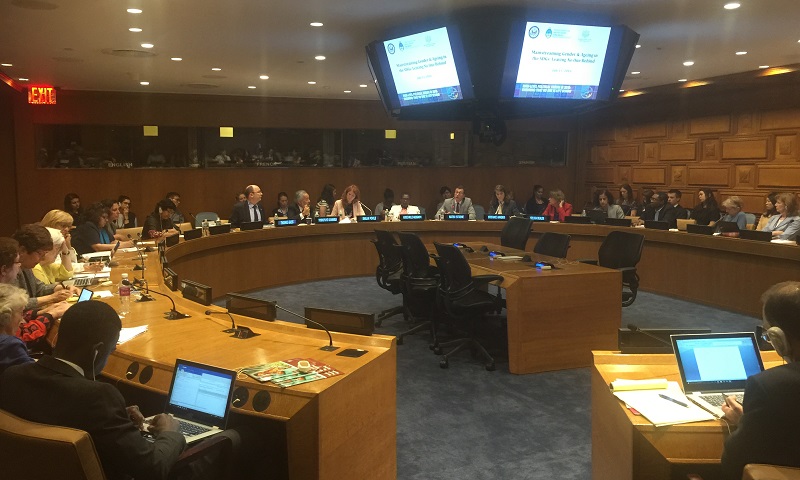
The invisibility of older women is a serious global issue that threatens to leave them at the margins of societies. Women aged 50 and over represent nearly one-quarter (23.6%) of all women around the world, yet them remain invisible in civil society, statistics and public policy. . The population aged 60 and over is expected to reach 1.4 billion in 2030 with the majority being women, typically living in low- and middle-income countries. To leave no one behind, policymakers must make older women visible and build inclusive programmes and policies for them. At a side event of the High Level Political Forum, held 13 July at UN Headquarters in New York, United Nations, Member State, and Civil Society representatives spoke about the challenges faced by an ageing female population and best practices for ensuring that they are not left behind.
UNDP representative Sarah Poole highlighted the importance of focusing on women, in order to implement the 2030 Agenda and achieve the Sustainable Development Goals (SDGs). Older women are central to communities, but face gender and age discrimination. Older women are also taking on inter-generational care burdens. In Japan, 70% of adult caregivers for elders are over 60 years of age. Older women are central to communities for care and education, but are largely excluded or forgotten about by the rest of society.
H.E. Mateo Estrémé, Deputy Permanent Representative of Argentina to the UN, stressed that “leave no one behind” cannot be just a catchphrase for the SDGs – substantial action needs to be taken on ageing women. Putting ageing and gender issues on the 2030 Agenda was a start, but with a lack of data that also does not disaggregate senior age or sex, older women will remain invisible and forgotten. Civil society needs to work with Member States and the UN to identify these gaps and data to ensure that all older women are included.
In Kenya, ageing women are made vulnerable by the migration of young people and the cost of living with little income, according to H.E Koki Muli Grignon, Deputy Permanent Representative of Kenya to the UN. The country, however, tries to ensure that older women are not left behind by entrenching the rights of older members of Kenyan society in Kenya’s constitution. In all social development programmes, including access to credit, social transfers, food and disaster relief, the mandate of these schemes require that elders, among other vulnerable members of society, have their needs met. It is a small, but formal foundational policy that ensures that older women in Kenya are not left behind.
To be effective in leaving no one behind, generational and gender gaps need to be bridged by focusing on older women. The UN DESA Assistant Secretary General, Thomas Gass, further emphasised the promise made to leave no one behind in the 2030 Agenda and the commitments made in the Madrid Plan on Ageing that commits to gender equality among older persons. To achieve the SDGs, helping older women needs to move on from intention to implementation.
The event was organized by UNDP in cooperation with the Permanent Missions of Argentina, Japan and the USA to the United Nations.
To learn more about our work on ageing at social.un.org/ageing
Source & Copyright: UNDESA DSPD
 Welcome to the United Nations
Welcome to the United Nations